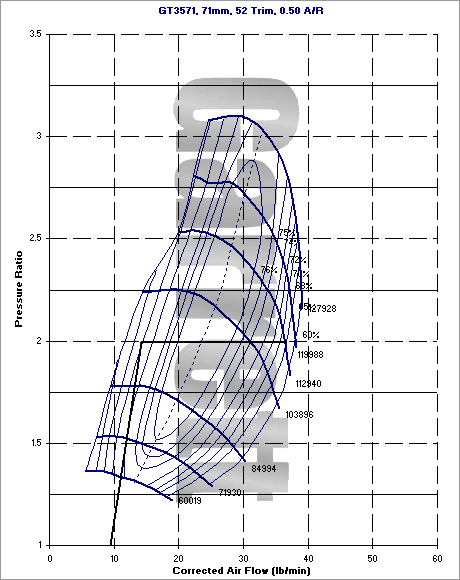K, i'm quite new to the whole turbo/performance stuff but I figured it was time to learn.
The first thing I decided to learn was how to read compressor maps.
I am working with a 2.2 Ecotec just running stock sizing. I know the internals would be need to be forged and what not but would this be a good turbo...
Garrett GT3571, 71MM, 52 Trim, 0.5 A/R
Running at 14.5 PSI

Please excuse my writing of the turbo numbers. I'm not too sure how else to write um.
Would that be a good turbo to go with to make in the 400-500 range?
If not, please explain why not. And please don't just give me an answer.
That is one thing I don't get. I think I can pick a turbo that'll "fit" the car, but I don't know how to guesstimate how much power will be made. Or is that just an experience thing??
Help is greatly appreciated. Just ask if something I said doesn't make sense.
Thanks
-Seth

considering you didn't out line WHAT your thinking of compressor maps was, all you asked really was if that turbo, on an Eco, can make 400-500hp........ and if not, can someone tell you how to read the Maps......
SPD RCR Z -
'02 Z24 420whp
SLO GOAT -
'04 GTO 305whp
W41 BOI -
'78 Buick Opel Isuzu W41 Swap

Ok, thats all you needed to ask.
I did it based on a way learned off this BMW site.
Anyways, you use the spredsheet he made to find the LB/MIN at 2000 RPM and at 3000 RPM. I don't know how to find the VE so I used his default value of 90.
At 2000 RPM the lb/min is 9.81 and at 3000 RPM it is 14.71.
Then, I draw a line from the 9.81 up to the pressure ratio (at 14.5 PSI is 2) then over to 14.71 on the lb/min.
Then you extend that line to the max RPM lb/min which at 7500 is 36.7.
Like this...

Then I saw that that fit pretty well so then I asked if that would do good or not.
-Seth

That is horrible^
There are formulas that need to be followed in order to read those maps correctly (or even be remotely close).
1st rule: your engine won't be near 90% VE in stock trim, not to mention at 2000 rpm...
There are a couple posts in this forum about how to read the maps. There is one that is especially well written in which I posted some maps and PJ wrote a description on the calculations. There are also quite a few posts that link to that thread, so just run a quick search.

fortune cookie say:
better a delay than a disaster.
Well the link I found was
this link.
And it looks like I did basically exactly what he did. He even said in there that even the 2200 could put in as a 90% VE.
I used
this site to figure out my first one.
I'll do another one with actually doin PJ's way and I'll see how it changes.
-Seth

Definately not the thread I was talking about, and you most definately should not be using 90%, especially at 2000rpm.
Here's the link

fortune cookie say:
better a delay than a disaster.
props for actually trying to learn and doing your research first. The turbocharger you have picked (not taking altitude, VE, etc, etc) is a fairly large turbocharger. But if you are power hungry, it should be a fairly decent size. And don't worry about being flamed, we all flame from time to time.
Just from glancing at that compressor map, it becomes much more effiecent at higher pressures, you may want to consider something with a slightly larger trim, just a thought
HP Tuners | Garrett T3/T04B | 2.5" Charge Pipes | 2.5" Downpipe | 650 Injectors | HO Manifold | Addco front/rear | Motor Mounts | HKS SSQV | Spec stage 3 | AEM UEGO Wideband | Team Green LSD | FMIC | 2.3 cams | 2.3 oil pump swap | 280WHP | Now ECOTECED










